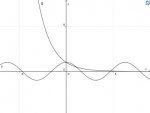y = cosx, y = (1/2)^x
- State four points where y = cosx = y = (1/2)^x
- Why are there an infinite number of such points?
I've gotten the graphs but except for x = 0, I don't know which other points to choose. The graph can be seen below:

I need to get this in by tomorrow so if any of you wonderfolks can help me out with this, that'd be great. Thanks ofcourse!
On a sidenote: Would it be right to say that sinx ≤ x when x > 0?
- State four points where y = cosx = y = (1/2)^x
- Why are there an infinite number of such points?
I've gotten the graphs but except for x = 0, I don't know which other points to choose. The graph can be seen below:

I need to get this in by tomorrow so if any of you wonderfolks can help me out with this, that'd be great. Thanks ofcourse!
On a sidenote: Would it be right to say that sinx ≤ x when x > 0?
